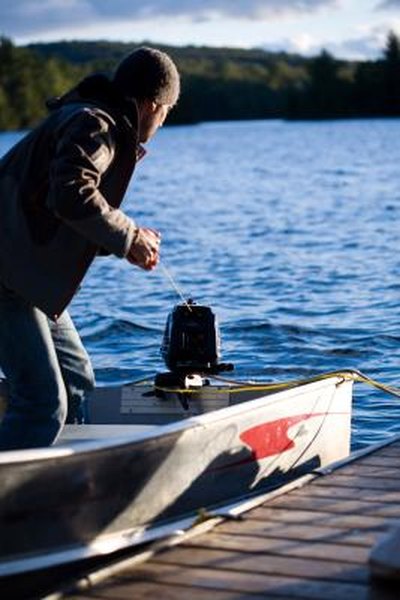
Outboard engines are popular in small watercraft because of their light weight and wide range of size for both low and high power applications. Outboard engines, as with any internal combustion engine, require air, fuel and spark to maintain adequate combustion throughout the power band. Problems with the delivery of any of these combustion components can cause an engine to stall while under acceleration.
Poorly-Tuned Carburetor
The carburetor is responsible for the combination of air and fuel called the fuel mixture. If the ratio of fuel to air becomes too high or too low, the engine will run poorly, especially while accelerating. This is because a rich fuel mixture is over-saturated with gas, causing ignition problems. Mixtures that have too much air and not enough fuel are lean and tend to reduce the amount of power available under load and can cause stalling. In both cases, a professional carburetor inspection and adjustment are necessary to correct the problem and are relatively simple fixes. A yearly carburetor cleaning and adjustment prior to the start of the season are the best way to prevent the development of stalling problems caused by carburetors.
Intake Manifold Leak
Because outboard engines tend to sit over the winter time, holes in the intake manifold gasket can occur. These increase the air intake, causing a lean fuel mixture and vacuum pressure problems. The result is poor acceleration, rough idle and stalling. A manifold leak is easily detected by a hissing sound coming from the source of the leak. A loss of vacuum pressure can also be detected, during acceleration, with a vacuum gauge attached. Once the leak is found, replacing the gasket, rubber intake or manifold components responsible for the leak will fix the problem.
Fouled Spark Plugs
Spark plugs are responsible for the ignition of fuel in the cylinder but will eventually foul in response to carbon buildup from normal combustion of oil in the cylinder. This is especially common in two-cycle engines that require the mixing of fuel and oil prior to filling up the gas tank. Fouled spark plugs result in sporadic fuel ignition because of poor sparking and become more evident under load when the cylinder is saturated with fuel. Spark plug fouling can be detected by removing the spark plugs and comparing them with a plug color chart. Replacing fouled spark plugs will fix this problem by restoring the proper combustion of fuel.
Clogged Fuel Line
A clogged fuel line inhibits the flow of fuel from the boat's gas tank to the engine. Fuel filters help reduce this problem by filtering particles from the fuel before they can reach small, easy-to-clog lines. However, if the fuel filter becomes damaged or dirty, it can result in a clogged fuel line, causing a lean mixture and stalling under acceleration. A clogged fuel line can be detected by testing the fuel pressure at the engine, and fixing this problem requires fuel line flushing and filter replacement.
References
Writer Bio
Justin Chen is a freelance writer and photographer with 6 years of professional experience in outdoor activities, extreme sports, travel and marketing topics. His professional work experience includes publication with KOMO 4 News Seattle, Fisher Interactive Network, and Demand Studios. He is a current Pre-Med student at Walla Walla University.



